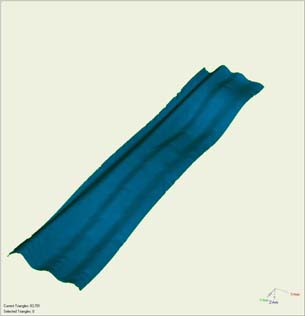Fast App: An Ounce of Prevention ...
Laser Design's scanner showed the fallacy of a hypothesis--and saved a corporation from making a costly mistake.
Latest News
December 14, 2010
By DE Editors
 |
Embossing serves several purposes on the surface and within absorbent pads of disposable hygiene products. On the surface, embossing can introduce an aesthetically pleasing pattern onto the pad—appearing soft, which can also affect fit and comfort attributes. It also has a functional purpose of controlling and directing surface flows.
The embossing process is evaluated by the resulting embossing quality, which may be a composite measure of embossing depth, breadth and shape.
As with all commercial machines, there is a continual push to increase the machine line speed at Kimberly-Clark. Based on previous research and the theoretical balance of extrusion rates and shear deformation, it was believed that embossing quality is a function of both embossing gap (pressure) and machine speed. It was expected that the embossing quality with the current module at increasing speeds would decrease. More importantly, it was hypothesized that a larger embossing module could actually improve embossing with higher speeds. This would provide a reason to invest in larger embossing modules.
A Closer Look
Theoretically, a larger-diameter embossing roll would yield higher-quality embossing than modules with a smaller roll. A qualitative direct comparison of the current embosser and the proposed larger module was made by the project team, who concluded that only marginally better embossing was possible with the larger roll. Furthermore, the larger embossing module was more expensive than its smaller counterpart and more difficult to fit into the process because of the larger size. To justify investment in larger embossing modules, they decided, more compelling evidence was required.
| About Kimberly-Clark Kimberly-Clark and its well-known global brands are indispensable parts of life for people in more than 150 countries over the company’s 137-year history of innovation. Every day, 1.3 billion people—nearly a quarter of the world’s population—use K-C brands, including Kleenex, Scott, Huggies, Pull-Ups, Kotex and Depend. Kimberly-Clark holds the No. 1 or No. 2 share position in more than 80 countries. |
Topographical parameters were traditionally estimated using a technique referred to as “shadow casting.” Angled illumination resulted in a relief image characterized by shadows cast from the sample’s topography. Through image analysis, the shadows’ breadth, darkness and spatial arrangement were used to infer topographical parameters.
The technique used an assumed topography; therefore, measured parameters were indirect. Because many of the materials of interest were fibrous and may have had significant diffuse scattering from a variety of depths, it was necessary to coat the samples so that shadows were cast onto the uppermost surface. The coating and subsequent drying processes had topographical consequences.
Non-contact laser scanning was a suitable alternative to traditional shadow casting for determining embossing volume and depth. Moreover, sample preparation was easier, primarily consisting of aligning the sample in the scan plane, setting the necessary scanning parameters, and collecting the data. Samples could remain uncoated. Acquisition was much faster, and depth measurements were more direct than shadow casting. Therefore, a method to measure embossing volume using the Laser Design, Inc. Surveyor RPS120 non-contact laser scanner and image analysis was used.
Coarse scanning parameters allowed scans of an 8x3-in. area in less than a minute—with better than 0.1mm lateral resolution and 10 micron depth resolution. The technique provided fast and direct measurements of macroscopic topographical features, such as embossing.
With the development of appropriate macros, this technique could be used for more routine testing of embossing and other macroscopic topographical structures.
The Results
At increased line speeds, virtually the same embossing quality was possible with both the current module and the larger module. This evidence was contrary to the hypothesis that embossing quality would improve with increased line speed using larger embossing modules. This data supported the decision not to invest in larger embossing modules and rather, to continue to utilize the current modules—saving the corporation almost $500,000.
More Info:
Laser Design, Inc.
Subscribe to our FREE magazine, FREE email newsletters or both!
Latest News
About the Author
DE’s editors contribute news and new product announcements to Digital Engineering.
Press releases may be sent to them via [email protected].






